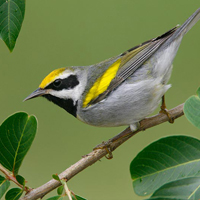Golden-winged warbler
Scientific name: Vermivora chrysoptera

Cover photo credit: Brian E. Small
Status
Special Concern
“Special Concern” means the species lives in the wild in Ontario, is not endangered or threatened, but may become threatened or endangered due to a combination of biological characteristics and identified threats.
Date added to the Species at Risk in Ontario List
The Golden-winged Warbler was already assessed as a species of special concern when the Endangered Species Act took effect in 2008.
What it looks like
The Golden-winged Warbler is a small grey songbird – about 11 centimetres long – with white undersides and distinctive yellow wing patches and forehead. Males have a black throat and black patch behind their eyes; females have the same markings in grey.
Golden-winged Warblers usually breed when a year old and can continue to do so until they are nine. Pairs build their nests on the ground, where the female lays two to six eggs.
During the breeding season, these warblers eat insects only, primarily caterpillars, moths, other winged insects, and spiders. Similar feeding habits are seen in regions where the warblers spend the winter.
Where it lives
Golden-winged Warblers prefer to nest in areas with young shrubs surrounded by mature forest – locations that have recently been disturbed, such as field edges, hydro or utility right-of-ways, or logged areas.
Where it’s been found in Ontario
The Golden-winged Warbler is found in southern Saskatchewan, Manitoba, Ontario, and Quebec, as well as the north-eastern United States. In Ontario, these birds breed in central-eastern Ontario, as far south as Lake Ontario and the St. Lawrence River, and as far north as the northern edge of Georgian Bay. Golden-winged Warblers have also been found in the Lake of the Woods area near the Manitoba border, and around Long Point on Lake Erie.
Golden-winged Warblers spend the winter in Central America, some Caribbean islands, and the northern part of South America.
View a Larger version of this map (PDF)
What threatens it
Loss of habitat in eastern North America is one threat to the Golden-winged Warbler. These warblers will mate with Blue-winged Warblers, producing hybrids with characteristics from both species. This hybridization is another threat to Golden-winged Warbler populations. Over generations the Golden-winged Warblers are replaced by the Blue-winged Warblers. In addition to hybridization, “nest parasitism” by Brown-headed Cowbirds is a threat. The cowbirds lay their eggs in other species’ nests, and the young cowbirds are fed by the host parents at the expense of their own young.
Action we are taking
Special concern species do not receive species or habitat protection.
What you can do
Report a sighting
- Report a sighting of an endangered animal or plant to the Natural Heritage Information Centre. Photographs with specific locations or mapping coordinates are always helpful.
- Bird Studies Canada is working to advance the understanding, appreciation and conservation of wild birds and their habitat in Ontario and elsewhere. For more information on how you can help, visit: www.bsc-eoc.org.
Volunteer
- Volunteer with your local nature club or provincial park to participate in surveys or stewardship work focused on species at risk.
Be a good steward
- Private land owners have a very important role to play in species recovery. You may be eligible for stewardship programs that support the protection and recovery of species at risk and their habitats.
Report illegal activity
- Report any illegal activity related to plants and wildlife to
1-877-TIP-SMNR (847-7667) .
Quick facts
- Golden-winged Warblers tend to nest in loose groups or “colonies” that contain up to ten pairs of breeding birds.
- These warblers leave Ontario for the tropics in late August and early September, returning around mid-May.
- Golden-winged Warblers often return to the same areas to nest year after year. Both males and females have been identified at the same breeding territory for seven years.
- The Golden-winged Warbler resembles the Black-capped Chickadee, and it is sometimes easy to confuse these species, both of which feed head down at the ends of branches.
